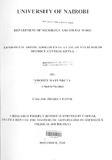| dc.description.abstract | Unprotected sexual intercourse among Kenyan's teenagers has many serious public health
and societal consequences, particularly the transmission of HIV and other STIs. The risk of
STD transmission among youths may be reduced by encouraging safer sexual behaviors,
such as the use of condoms and abstinence. However, consistent and correct condom use
among teenagers has remained unachieved. This research paper will look at the factors
effecting condom use among teenagers in Kamariki Sub-location, Nyeri North District in
central province, Kenya.
The main objective of this research is to identify the background facotors that promote use
and non-use of condom among adolescents in terms of, personal, behaviors, social cultural
factors and attitudes among teenagers 15-19 years old. Data was collected from a sample of
204 respondents adolescents aged 15-19 recruited using purposive and snow-balling
sampling techniques. The data collected was on knowledge, attitudes and practices of
condom use. Key informants interviews were also conducted. Survey data was analyzed
using Statistical Package for Social Science SPSS software, while the qualitative data was
analyzed manually
The condom use among teenagers was inconsistent, and sexual activities were unplanned.
Age, sex, risk perceptions and the type of relationship a teenager is involved were found to
determines if a teenager will use or not use a condom. Majority of the sexually active
teenagers were boys compared to the girls and use of condom was more with the teenage
boys. The study also found that in this rural area, HIV /AIDS knowledge was high and
nearly universal. Teenagers were also well conversant with prevention methods but despite
this knowledge condom utilization and uptake was inconsistent and slightly above 50%.
The following are the reasons for low condom use
• Social disapproval and negative symbolic meaning translating into embarrassment
• Lack of access to condom
• High cost of condom compared to income levels.
This study recommends that to realize consistency in condom use among teenagers, there is
dire need for positive behavior reinforcement, access to information on condom use, peer
education and counseling in primary school and review of policy that creates an enabling
environment regarding sexual reproduction health and condom use | en |

